Simultaneously Estimating Process Variation Effect, Work Function Fluctuation, and Random Dopant Fluctuation of Gate-All-Around Silicon Nanosheet Complementary Field-Effect Transistors
Abstract
1. Introduction
2. Three-Dimensional Statistical Device Simulation of PVE and IPF Factors
3. Results and Discussion
4. Conclusions
Author Contributions
Funding
Data Availability Statement
Conflicts of Interest
References
- Huang, C.-Y.; Dewey, G.; Mannebach, E.; Phan, A.; Morrow, P.; Rachmady, W.; Tung, I.-C.; Thomas, N.; Alaan, U.; Paul, R.; et al. 3-D self-aligned stacked NMOS-on-PMOS nanoribbon transistors for continued moore’s law scaling. In Proceedings of the 2020 IEEE International Electron Devices Meeting (IEDM), San Francisco, CA, USA, 12–18 December 2020; pp. 425–428. [Google Scholar] [CrossRef]
- Yu, X.-R.; Chang, S.-W.; Chang, W.-H.; Hong, T.-C.; Chiang, C.-H.; Lu, W.-H.; Yang, C.-Y.; Chen, W.-J.; Lin, J.-H.; Wu, P.-H.; et al. Integration Design and Process of 3-D Heterogeneous 6T SRAM with Double Layer Transferred Ge/2Si CFET and IGZO Pass Gates for 42% Reduced Cell Size. In Proceedings of the 2022 IEEE International Electron Devices Meeting (IEDM), San Francisco, CA, USA, 3–7 December 2022; pp. 2051–2054. [Google Scholar] [CrossRef]
- Jegadheesan, V.; Sivasankaran, K.; Konar, A. Optimized Substrate for Improved Performance of Stacked Nanosheet Field-Effect Transistor. IEEE Trans Electron Devices 2020, 67, 4079–4084. [Google Scholar] [CrossRef]
- Kola, S.R.; Li, Y. Effects of Bottom Channel Coverage Ratio on Leakage Current and Static Power Consumption of Vertically Stacked GAA Si NS FETs Effects of Bottom Channel Coverage Ratio on Leakage Current and Static Power Consumption of Vertically Stacked GAA Si NS FETs. ECS J. Solid State Sci. Technol. 2025, 14, 025001. [Google Scholar] [CrossRef]
- Kola, S.R.; Li, Y.; Butola, R. Statistical Device Simulation and Machine Learning of Process Variation Effects of Vertically Stacked Gate-All-Around Si Nanosheet CFETs. IEEE Trans. Nanotechnol. 2024, 23, 386–392. [Google Scholar] [CrossRef]
- Sun, Y.; Gao, H.; Li, X.; Yang, X.; Liu, Z.; Liu, Y.; Li, X.; Shi, Y. Impact of Process Fluctuations on RF Small-Signal Parameter of Gate-All-Around Nanosheet Transistor beyond 3 nm Node. IEEE Trans. Electron Devices 2022, 69, 31–38. [Google Scholar] [CrossRef]
- Sarkar, E.; Zhang, C.; Chakraborty, D.; Waqar, F.G.; Kirtania, S.; Aabrar, K.A.; Park, H.; Shin, J.; Tian, M.; I Khan, A.; et al. First Demonstration of W-doped In2 O3 Gate-All-Around ( GAA ) Nanosheet FET with Improved Performance and Record Threshold Voltage Stability. In Proceedings of the 2024 IEEE International Electron Devices Meeting (IEDM), San Francisco, CA, USA, 7–11 December 2024; pp. 1–4. [Google Scholar] [CrossRef]
- Mortelmans, W.; Buragohain, P.; Kitamura, A.; Dorow, C.; Rogan, C.; Siddiqui, L.; Ramamurthy, R.; Lux, J.; Zhong, T.; Harlson, S.; et al. Gate oxide module development for scaled GAA 2D FETs enabling SS < 75mV/d and record Idmax > 900µA/µm at Lg < 50nm. In Proceedings of the 2024 IEEE International Electron Devices Meeting (IEDM), San Francisco, CA, USA, 7–11 December 2024; pp. 2–5. [Google Scholar] [CrossRef]
- Kumari, N.A.; Sreenivasulu, V.B.; Vijayvargiya, V.; Upadhyay, A.K.; Ajayan, J.; Uma, M. Performance Comparison of Nanosheet FET, CombFET, and TreeFET: Device and Circuit Perspective. IEEE Access 2024, 12, 9563–9571. [Google Scholar] [CrossRef]
- Kola, S.R.; Li, Y. Electrical Characteristic and Power Fluctuations of GAA Si NS CFETs by Simultaneously Considering Six Process Variation Factors. IEEE Open J. Nanotechnol. 2023, 4, 229–238. [Google Scholar] [CrossRef]
- Sung, P.-J.; Chang, C.-Y.; Chen, L.-Y.; Kao, K.-H.; Su, C.-J.; Liao, T.-H.; Fang, C.-C.; Wang, C.-J.; Hong, T.-C.; Jao, C.-Y.; et al. Voltage Transfer Characteristic Matching by Different Nanosheet Layer Numbers of Vertically Stacked Junctionless CMOS Inverter for SoP/3D-ICs applications. In Proceedings of the 2018 IEEE International Electron Devices Meeting (IEDM), San Francisco, CA, USA, 1–5 December 2018; pp. 504–507. [Google Scholar] [CrossRef]
- Sreenivasulu, V.B.; Neelam, A.K.; Kola, S.R.; Singh, J.; Li, Y. Exploring the Performance of 3-D Nanosheet FET in Inversion and Junctionless Modes: Device and Circuit-Level Analysis and Comparison. IEEE Access 2023, 11, 90421–90429. [Google Scholar] [CrossRef]
- Chao, P.J.; Li, Y. Impact of geometry aspect ratio on 10-nm gate-all-around silicon-germanium nanowire field effect transistors. In Proceedings of the 14th IEEE International Conference on Nanotechnology, Toronto, ON, Canada, 18–21 August 2014; pp. 452–455. [Google Scholar] [CrossRef]
- Chiang, H.L.; Chen, T.C.; Wang, J.F.; Mukhopadhyay, S.; Lee, W.K.; Chen, C.L.; Khwa, W.S.; Pulicherla, B.; Liao, P.J.; Su, K.W.; et al. Cold CMOS as a Power-Performance-Reliability Booster for Advanced FinFETs. In Proceedings of the 2020 IEEE Symposium on VLSI Technology, Honolulu, HI, USA, 16–19 June 2020; pp. 1–2. [Google Scholar] [CrossRef]
- Sreenivasulu, V.B.; Kumari, N.A.; Lokesh, V.; Ajayan, J.; Uma, M.; Vijayvargiya, V. Design of Resistive Load Inverter and Common Source Amplifier Circuits Using Symmetric and Asymmetric Nanowire FETs. J. Electron. Mater. 2023, 52, 7268–7279. [Google Scholar] [CrossRef]
- Rathore, S.; Jaisawal, R.K.; Kondekar, P.N.; Bagga, N. Demonstration of a Nanosheet FET With High Thermal Conductivity Material as Buried Oxide: Mitigation of Self-Heating Effect. IEEE Trans. Electron Devices 2023, 70, 1970–1976. [Google Scholar] [CrossRef]
- Al-Ameri, T.; Georgiev, V.P.; Adamu-Lema, F.; Asenov, A. Simulation Study of Vertically Stacked Lateral Si Nanowires Transistors for 5-nm CMOS Applications. IEEE J. Electron Devices Soc. 2017, 5, 466–472. [Google Scholar] [CrossRef]
- Seoane, N.; Fernandez, J.G.; Kalna, K.; Comesana, E.; Garcia-Loureiro, A. Simulations of statistical variability in n-Type FinFET, nanowire, and nanosheet FETs. IEEE Electron Device Lett. 2021, 42, 1416–1419. [Google Scholar] [CrossRef]
- Yang, X.; Sun, Y.; Liu, Z.; Liu, Y.; Li, X.; Shi, Y. 3-D Modeling of Fringe Gate Capacitance in Complementary FET (CFET). IEEE Trans. Electron Devices 2022, 69, 5978–5984. [Google Scholar] [CrossRef]
- Shi, X.; Member, G.S.; Liu, T.; Wang, Y.; Member, G.S. A Simulation Study of Junctionless Forksheet on Sub-2 nm Node Logic Applications. IEEE Trans. Electron Devices 2023, 70, 3413–3418. [Google Scholar] [CrossRef]
- Kumari, N.A.; Karumuri, S.R.; Ajayan, J.; Vijayvargiya, V.; Upadhyay, A.K.; Uma, M.; Kumar, A.S. Design and Analysis of dual-k spacer CombFET for Digital and Synaptic Applications. IEEE Access 2024, 1–10. [Google Scholar] [CrossRef]
- Yang, X.; Li, X.; Liu, Z.; Sun, Y.; Liu, Y.; Li, X.; Shi, Y. Impact of Process Variation on Nanosheet Gate-All-Around Complementary FET (CFET). IEEE Trans. Electron Devices 2022, 69, 4029–4036. [Google Scholar] [CrossRef]
- Kobrinsky, M.; Silva, J.D.; Mannebach, E.; Mills, S.; El Qader, M.A.; Adebayo, O.; Radhakrishna, N.A.; Beasley, M.; Chawla, J.; Chugh, S.; et al. Process Innovations for Future Technology Nodes with Back-Side Power Delivery and 3D Device Stacking. In Proceedings of the 2023 International Electron Devices Meeting (IEDM), San Francisco, CA, USA, 9–13 December 2023; pp. 2–5. [Google Scholar] [CrossRef]
- Jeong, H.; Woo, S.; Choi, J.; Cho, H.; Member, S. Fast and Expandable ANN-Based Compact Model and Parameter Extraction for Emerging Transistors. IEEE J. Electron Devices Soc. 2023, 11, 153–160. [Google Scholar] [CrossRef]
- Kim, G.; Shin, H.; Eom, T.; Jung, M.; Kim, T.; Lee, S.; Kim, M.; Jeong, Y.; Kim, J.-S.; Nam, K.-J.; et al. Design Guidelines of Thermally Stable Hafnia Ferroelectrics for the Fabrication of 3D Memory Devices. In Proceedings of the 2022 International Electron Devices Meeting (IEDM), San Francisco, CA, USA, 3–7 December 2022; pp. 106–109. [Google Scholar] [CrossRef]
- Chuang, M.H.; Kola, S.R.; Li, Y. Characteristic Variability of GAA Si NS CFETs Induced by Process Variation Effect and Intrinsic Parameter Fluctuation. In Proceedings of the 2024 International Conference on Simulation of Semiconductor Processes and Devices (SISPAD), San Jose, CA, USA, 24–27 September 2024; pp. 1–4. [Google Scholar] [CrossRef]
- Subramanian, S.; Hosseini, M.; Chiarella, T.; Sarkar, S.; Schuddinck, P.; Chan, B.T.; Radisic, D.; Mannaert, G.; Hikavyy, A.; Rosseel, E.; et al. First Monolithic Integration of 3D Complementary FET (CFET) on 300 mm Wafers. In Proceedings of the 2020 IEEE Symposium on VLSI Technology, Honolulu, HI, USA, 16–19 June 2020; pp. 1–2. [Google Scholar] [CrossRef]
- Zhang, Q.; Zhang, Y.; Luo, Y.; Yin, H. New structure transistors for advanced technology node CMOS ICs. Natl. Sci. Rev. 2024, 11, nawae008. [Google Scholar] [CrossRef]
- Diaz, C.H. Logic Technology Device Innovations. In Proceedings of the 2024 IEEE International Electron Devices Meeting (IEDM), San Francisco, CA, USA, 7–11 December 2024; pp. 1–4. [Google Scholar] [CrossRef]
- Kang, W.; Wu, J.; Cheng, Y.; Wang, Y. A Complementary FET ( CFET ) -Based NAND Design to Reduce RC Delay. IEEE Electron Device Lett. 2022, 43, 678–681. [Google Scholar] [CrossRef]
- Jang, D.; Jung, S.G.; Min, S.J.; Yu, H.Y. Electrothermal Characterization and Optimization of Monolithic 3D Complementary FET (CFET). IEEE Access 2021, 9, 158116–158121. [Google Scholar] [CrossRef]
- Kola, S.R.; Li, Y.; Chuang, M.H. Intrinsic Parameter Fluctuation and Process Variation Effect of Vertically Stacked Silicon Nanosheet Complementary Field-Effect Transistors. In Proceedings of the 2023 24th International Symposium on Quality Electronic Design (ISQED), San Francisco, CA, USA, 5–7 April 2023; pp. 383–390. [Google Scholar] [CrossRef]
- International Roadmap for Devices and SystemsTM 2023 Update More Moore; IEEE: Piscataway, NJ, USA, 2023.
- Vandooren, A.; Stiers, K.; Sheng, C.; Cavalcante, C.T.d.C.; Hosseini, M.; Batuk, D.; Peng, A.; Zhou, X.; Mertens, H.; Veloso, A.; et al. Monolithic-CFET with Direct Backside Contact to Source/Drain and Backside Dielectric Isolation. In Proceedings of the 2024 IEEE International Electron Devices Meeting (IEDM), San Francisco, CA, USA, 7–11 December 2024; pp. 1–4. [Google Scholar] [CrossRef]
- Kükner, H.; Mirabelli, G.; Yang, S.; Verschueren, L.; Bömmels, J.; Lin, J.Y.; Abdi, D.; Farokhnejad, A.; Zografos, A.; Horiguchi, N.; et al. Double-Row CFET: Design Technology Co- Optimization for Area Efficient A7 Technology Node. In Proceedings of the 2024 IEEE International Electron Devices Meeting (IEDM), San Francisco, CA, USA, 7–11 December 2024; pp. 1–4. [Google Scholar] [CrossRef]
- Liao, S.; Yang, L.; You, W.; Wu, T.; Lee, Y.; Chiu, T.; Hsu, J.; Ho, W.; Yang, Y.; Tsai, M.; et al. First Demonstration of Monolithic CFET Inverter at 48nm Gate Pitch Toward Future Logic Technology Scaling. In Proceedings of the 2024 IEEE International Electron Devices Meeting (IEDM), San Francisco, CA, USA, 7–11 December 2024; pp. 3–6. [Google Scholar] [CrossRef]
- Mii, Y. Semiconductor Industry Outlook and New Technology Frontiers. In Proceedings of the 2024 IEEE International Electron Devices Meeting (IEDM), San Francisco, CA, USA, 7–11 December 2024; pp. 1–6. [Google Scholar]
- Xu, L.; Kumar, A.; Quezada, E.; Jiang, J.; Oh, G.; Agashiwala, K.; Jiang, J.; Pal, A.; Cao, W.; Lee, M.; et al. Analysis and Implication of Electrothermal Effects in Emerging 3D Transistors and Integration Topologies with Two-dimensional Semiconductors. In Proceedings of the 2024 IEEE International Electron Devices Meeting (IEDM), San Francisco, CA, USA, 7–11 December 2024; pp. 14–17. [Google Scholar]
- Vincent, B.; Boemmels, J.; Ryckaert, J.; Ervin, J. A Benchmark Study of Complementary-Field Effect Transistor (CFET) Process Integration Options Done by Virtual Fabrication. IEEE J. Electron Devices Soc. 2020, 8, 668–673. [Google Scholar] [CrossRef]
- Ding, R.; Liu, Y.; Zhao, G.; Xu, Z.; Zhao, Y.; Tang, H.; Zhao, Y.; Xie, Q.; Lu, Y.; Zhu, X.; et al. A Novel Zigzag SRAM Bitcell Design in the Complementary FET Framework. IEEE Trans. Electron Devices 2023, 70, 4622–4627. [Google Scholar] [CrossRef]
- Agrawal, A.; Chakraborty, W.; Li, W.; Ryu, H.; Markman, B.; Hoon, S.H.; Paul, R.K.; Huang, C.Y.; Choi, S.M.; Rho, K.; et al. Silicon RibbonFET CMOS at 6nm Gate Length. In Proceedings of the 2024 IEEE International Electron Devices Meeting (IEDM), San Francisco, CA, USA, 7–11 December 2024; pp. 2–5. [Google Scholar] [CrossRef]
- Butola, R.; Li, Y.; Kola, S.R. Compact Model Build Upon Dynamic Weighting Artificial Neural Network Approach for Complementary Field Effect Transistors. IEEE Trans. Electron Devices 2024, 71, 246–253. [Google Scholar] [CrossRef]
- Seoane, N.; Martinez, A.; Brown, A.R.; Barker, J.R.; Asenov, A. Current variability in Si nanowire MOSFETs due to random dopants in the source/drain regions: A fully 3-D NEGF simulation study. IEEE Trans. Electron Devices 2009, 56, 1388–1395. [Google Scholar] [CrossRef]
- Ota, K.; Deguchi, J.; Fujii, S.; Saitoh, M.; Yamaguchi, M.; Berdan, R.; Marukame, T.; Nishi, Y.; Matsuo, K.; Takahashi, K.; et al. Performance Maximization of In-Memory Reinforcement Learning with Variability-Controlled Hf1-xZrxO2 Ferroelectric Tunnel Junctions. In Proceedings of the 2019 IEEE International Electron Devices Meeting (IEDM), San Francisco, CA, USA, 7–11 December 2019; pp. 114–117. [Google Scholar] [CrossRef]
- Mohapatra, E.; Jena, D.; Das, S.; Jena, J.; Dash, T. Work-Function Variability impact on the performance of Vertically Stacked GAA FETs for sub-7nm Technology Node. In Proceedings of the 2022 IEEE International Conference of Electron Devices Society Kolkata Chapter (EDKCON), Kolkata, India, 26–27 November 2022; pp. 440–444. [Google Scholar] [CrossRef]
- Vardhan, P.H.; Mittal, S.; Ganguly, S.; Ganguly, U. Analytical estimation of threshold voltage variability by metal gate granularity in FinFET. IEEE Trans. Electron Devices 2017, 64, 3071–3076. [Google Scholar] [CrossRef]
- Vardhan, P.H.; Amita; Ganguly, S.; Ganguly, U. Threshold Voltage Variability in Nanosheet GAA Transistors. IEEE Trans. Electron Devices 2019, 66, 4433–4438. [Google Scholar] [CrossRef]
- Yang, X.; Sun, Y.; Li, X.; Shi, Y.; Liu, Z. Compact Modeling of Process Variations in Nanosheet Complementary FET (CFET) and Circuit Performance Predictions. IEEE Trans. Electron Devices 2023, 70, 3935–3942. [Google Scholar] [CrossRef]
- Li, Y.; Hwang, C.-H.; Li, T.-Y.; Han, M.-H. Process-variation effect, metal-gate work-function fluctuation, and random-dopant fluctuation in emerging CMOS technologies. IEEE Trans. Electron Devices 2010, 57, 437–447. [Google Scholar] [CrossRef]
- Ko, K.; Lee, J.K.; Kang, M.; Jeon, J.; Shin, H. Prediction of Process Variation Effect for Ultrascaled GAA Vertical FET Devices Using a Machine Learning Approach. IEEE Trans. Electron Devices 2019, 66, 4474–4477. [Google Scholar] [CrossRef]
- Kola, S.R.; Li, Y.; Chen, C.; Chuang, M.H. A Unified Statistical Analysis of Comprehensive Fluctuations of Gate-All-Around Silicon Nanosheet MOSFETs Induced by RDF, ITF, and WKF Simultaneously. In Proceedings of the 2022 23rd International Symposium on Quality Electronic Design (ISQED), Santa Clara, CA, USA, 6–7 April 2022; pp. 1–6. [Google Scholar] [CrossRef]
- Li, Y.; Cheng, H.-W.; Chiu, Y.-Y.; Yiu, C.-Y.; Su, H.-W. A unified 3D device simulation of random dopant, interface trap and work function fluctuations on high-κ/metal gate device. In Proceedings of the 2011 International Electron Devices Meeting, Washington, DC, USA, 5–7 December 2011; pp. 107–110. [Google Scholar] [CrossRef]
- Li, Y.; Hwang, C.H.; Han, M.H. Simulation of characteristic variation in 16 nm gate FinFET devices due to intrinsic parameter fluctuations. Nanotechnology 2010, 21, 095203. [Google Scholar] [CrossRef] [PubMed]
- Vincent, B.; Hathwar, R.; Kamon, M.; Ervin, J.; Schram, T.; Chiarella, T.; Demuynck, S.; Baudot, S.; Siew, Y.K.; Kubicek, S.; et al. Process Variation Analysis of Device Performance Using Virtual Fabrication: Methodology Demonstrated on a CMOS 14-nm FinFET Vehicle. IEEE Trans. Electron Devices 2020, 67, 5374–5380. [Google Scholar] [CrossRef]
- Yang, Y.S.; Li, Y.; Kola, S.R. A Physical-Based Artificial Neural Networks Compact Modeling Framework for Emerging FETs. IEEE Trans. Electron Devices 2024, 71, 223–230. [Google Scholar] [CrossRef]
- Yoon, J.-S.; Lee, S.; Lee, J.; Jeong, J.; Yun, H.; Baek, R.-H. Reduction of Process Variations for Sub-5-nm Node Fin and Nanosheet FETs Using Novel Process Scheme. IEEE Trans. Electron Devices 2020, 67, 2732–2737. [Google Scholar] [CrossRef]
- Li, Y.; Chang, H.-T.; Lai, C.-N.; Chao, P.-J.; Chen, C.-Y. Process variation effect, metal-gate work-function fluctuation and random dopant fluctuation of 10-nm gate-all-around silicon nanowire MOSFET devices. In Proceedings of the 2015 IEEE International Electron Devices Meeting (IEDM), 2015, Washington, DC, USA, 7–9 December 2015; pp. 887–890. [Google Scholar] [CrossRef]
- Mohapatra, E.; Dash, T.; Jena, J.R.; Das, S.; Maiti, C.K. Strain induced variability study in Gate-All-Around vertically-stacked horizontal nanosheet transistors. Phys. Scr. 2020, 95, 065808. [Google Scholar] [CrossRef]
- Ko, K.; Kang, M.; Jeon, J.; Shin, H. Compact model strategy of metal-gate work-function variation for ultrascaled FinFET and vertical GAA FETs. IEEE Trans. Electron Devices 2019, 66, 1613–1616. [Google Scholar] [CrossRef]
- Kola, S.R.; Li, Y.; Chuang, M.H.; Endo, K.; Samukawa, S. Statistical Analysis of Intrinsic High-Frequency Characteristic Fluctuation of Emerging Silicon Gate-All-Around Nanosheet (NS) MOSFETs at Sub-3-nm Nodes. In Proceedings of the 7th IEEE Electron Devices Technology and Manufacturing Conference: Strengthen the Global Semiconductor Research Collaboration After the COVID-19 Pandemic, Seoul, Republic of Korea, 7–10 March 2023; pp. 1–3. [Google Scholar] [CrossRef]
- Martinez, A.; Aldegunde, M.; Seoane, N.; Brown, A.R.; Barker, J.R.; Asenov, A. Quantum-transport study on the impact of channel length and cross sections on variability induced by random discrete dopants in narrow gate-all-around silicon nanowire transistors. IEEE Trans. Electron Devices 2011, 58, 2209–2217. [Google Scholar] [CrossRef]
- Spinelli, A.S.; Member, S.; Compagnoni, C.M.; Member, S.; Lacaita, A.L. Variability Effects in Nanowire and Macaroni MOSFETs—Part I: Random Dopant Fluctuations. IEEE Trans. Electron Devices 2020, 67, 1485–1491. [Google Scholar] [CrossRef]
- Pal, A.; Vyas, P.B.; Dag, S.; Costrini, G.; Colombeau, B.; Haran, B.; Kengeri, S.; Bazizi, E.M. Novel Logic & SRAM Interconnect Design for Advanced Complementary FET ( CFET ) based Technology Nodes. In Proceedings of the 2024 IEEE International Electron Devices Meeting (IEDM), San Francisco, CA, USA, 7–11 December 2024; pp. 1–4. [Google Scholar] [CrossRef]
- Ryckaert, J.; Schuddinck, P.; Weckx, P.; Bouche, G.; Vincent, B.; Smith, J.; Sherazi, Y.; Mallik, A.; Mertens, H.; Demuynck, S.; et al. The Complementary FET (CFET) for CMOS scaling beyond N3. In Proceedings of the 2018 IEEE Symposium on VLSI Technology, Honolulu, HI, USA, 18–22 June 2018; pp. 141–142. [Google Scholar] [CrossRef]
- Li, Y.; Hwang, C.H. The effect of the geometry aspect ratio on the silicon ellipse-shaped surroundinggate field-effect transistor and circuit. Semicond. Sci. Technol. 2009, 24, 095018. [Google Scholar] [CrossRef]
- Sudarsanan, A.; Nayak, K. Immunity to random fluctuations induced by interface trap variability in Si gate-all-around n-nanowire field-effect transistor devices. J. Comput. Electron. 2021, 20, 1169–1177. [Google Scholar] [CrossRef]
- Franco, J.; Arimura, H.; Vici, A.; De Marneffe, J.F.; Molinaro, G.; Ganguly, J.; Lukose, L.; Degraeve, R.; Kaczer, B.; Mertens, H.; et al. Low Thermal Budget Multi- V th RMG Solution with Excellent TDDB and BTI Reliability by Combining Hydrogen Radical IL Treatment, n-Dipole-First Shifter and Low-Temperature HK PDA. In Proceedings of the 2024 IEEE International Electron Devices Meeting (IEDM), San Francisco, CA, USA, 7–11 December 2024; pp. 6–9. [Google Scholar] [CrossRef]
- Kola, S.R.; Chuang, M.H.; Li, Y. Characteristics Fluctuation of Sub-3-nm Bulk FinFET Devices Induced by Random Interface Traps. In Proceedings of the 2023 IEEE 23rd International Conference on Nanotechnology (NANO), Jeju City, Republic of Korea, 2–5 July 2023; pp. 917–922. [Google Scholar] [CrossRef]
- Li, Y.; Hwang, C.H.; Cheng, H.W. Process-variation- and random-dopants-induced threshold voltage fluctuations in nanoscale planar MOSFET and bulk FinFET devices. Microelectron. Eng. 2009, 86, 277–282. [Google Scholar] [CrossRef]
- Cheng, H.-W.; Li, F.-H.; Han, M.-H.; Yiu, C.-Y.; Yu, C.-H.; Lee, K.-F.; Li, Y. 3D Device Simulation of Work Function and Interface trap Fluctuations on High-κ/Metal Gate Devices. In Proceedings of the 2010 International Electron Devices Meeting, San Francisco, CA, USA, 6–8 December 2010; pp. 15.6.1–15.6.4. [Google Scholar] [CrossRef]
- Gu, J.; Zhang, Q.; Wu, Z.; Luo, Y.; Cao, L.; Cai, Y.; Yao, J.; Zhang, Z.; Xu, G.; Yin, H.; et al. Narrow Sub-Fin Technique for Suppressing Parasitic-Channel Effect in Stacked Nanosheet Transistors. IEEE J. Electron Devices Soc. 2022, 10, 35–39. [Google Scholar] [CrossRef]
- Ruch, B.; Jech, M.; Pobegen, G.; Grasser, T. Applicability of Shockley-Read-Hall Theory for Interface States. In In Proceedings of the 2020 IEEE International Electron Devices Meeting (IEDM), San Francisco, CA, USA, 12–18 December 2020; IEEE: New York, NY, USA, 2020; pp. 449–452. [Google Scholar] [CrossRef]
- SentaurusTM Device User Guide. Version O 2019; Synopsys, Inc.: Sunnyvale, CA, USA, 2019.
- Li, Y.; Cheng, H.W.; Han, M.H. Quantum hydrodynamic simulation of discrete-dopant fluctuated physical quantities in nanoscale FinFET. Comput Phys. Commun. 2011, 182, 96–98. [Google Scholar] [CrossRef]
- Matsukawa, T.; Liu, Y.; Mizubayashi, W.; Tsukada, J.; Yamauchi, H.; Endo, K.; Ishikawa, Y.; O’UChi, S.-I.; Ota, H.; Migita, S.; et al. Suppressing Vt and Gm variability of FinFETs using amorphous metal gates for 14 nm and beyond. In Proceedings of the 2012 International Electron Devices Meeting, San Francisco, CA, USA, 10–13 December 2012; pp. 175–178. [Google Scholar] [CrossRef]
- Matsukawa, T.; Fukuda, K.; Liu, Y.; Endo, K.; Tsukada, J.; Yamauchi, H.; Ishikawa, Y.; O’Uchi, S.; Mizubayashi, W.; Migita, S.; et al. Lowest variability SOI FinFETs having multiple Vt by back-biasing. In Proceedings of the 2014 Symposium on VLSI Technology (VLSI-Technology): Digest of Technical Papers, Honolulu, HI, USA, 9–12 June 2014; pp. 1–2. [Google Scholar] [CrossRef]
- Li, Y.; Chou, H.; Lee, J. Investigation of Electrical Characteristics on Surrounding-Gate and Omega-Shaped-Gate Nanowire FinFETs. IEEE Trans. Nanotechnol. 2005, 4, 510–516. [Google Scholar] [CrossRef]
- Asenov, A.; Wang, Y.; Cheng, B.; Wang, X.; Asenov, P.; Al-Ameri, T.; Georgiev, V.P. Nanowire transistor solutions for 5nm and beyond. In Proceedings of the 2016 17th International Symposium on Quality Electronic Design (ISQED), Santa Clara, CA, USA, 15–16 March 2016; pp. 269–274. [Google Scholar] [CrossRef]
- Kola, S.R.; Li, Y.; Chen, C.-Y.; Chuang, M.-H. Statistical 3D Device Simulation of Full Fluctuations of Gate-All-Around Silicon Nanosheet MOSFETs at Sub-3-nm Technology Nodes. In Proceedings of the 2022 International Symposium on VLSI Technology, Systems and Applications (VLSI-TSA), Hsinchu, Taiwan, 18–21 April 2022; Volume 42, pp. 1–2. [Google Scholar] [CrossRef]
- Yadav, N.; Jain, S.; Pattanaik, M.; Sharma, G. A novel stability and process sensitivity driven model for optimal sized FinFET based SRAM. Microelectron Reliab. 2015, 55, 1131–1143. [Google Scholar] [CrossRef]
- Chang, S.-W.; Li, J.-H.; Huang, M.-K.; Huang, S.-T.; Wang, H.-C.; Huang, Y.-J.; Wang, J.-Y.; Yu, L.-W.; Huang, Y.-F.; Hsueh, F.-K.; et al. First Demonstration of CMOS Inverter and 6T-SRAM Based on GAA CFETs Structure for 3D-IC Applications. In Proceedings of the 2019 IEEE International Electron Devices Meeting (IEDM), San Francisco, CA, USA, 7–11 December 2019; pp. 254–257. [Google Scholar] [CrossRef]
- Moroz, V.; Lin, X.-W.; Asenov, P.; Sherlekar, D.; Choi, M.; Sponton, L.; Melvin, L.S.; Lee, J.; Cheng, B.; Nannipieri, A.; et al. DTCO launches moore’s law over the feature scaling wall. In Proceedings of the 2020 IEEE International Electron Devices Meeting (IEDM), San Francisco, CA, USA, 12–18 December 2020; pp. 913–916. [Google Scholar] [CrossRef]
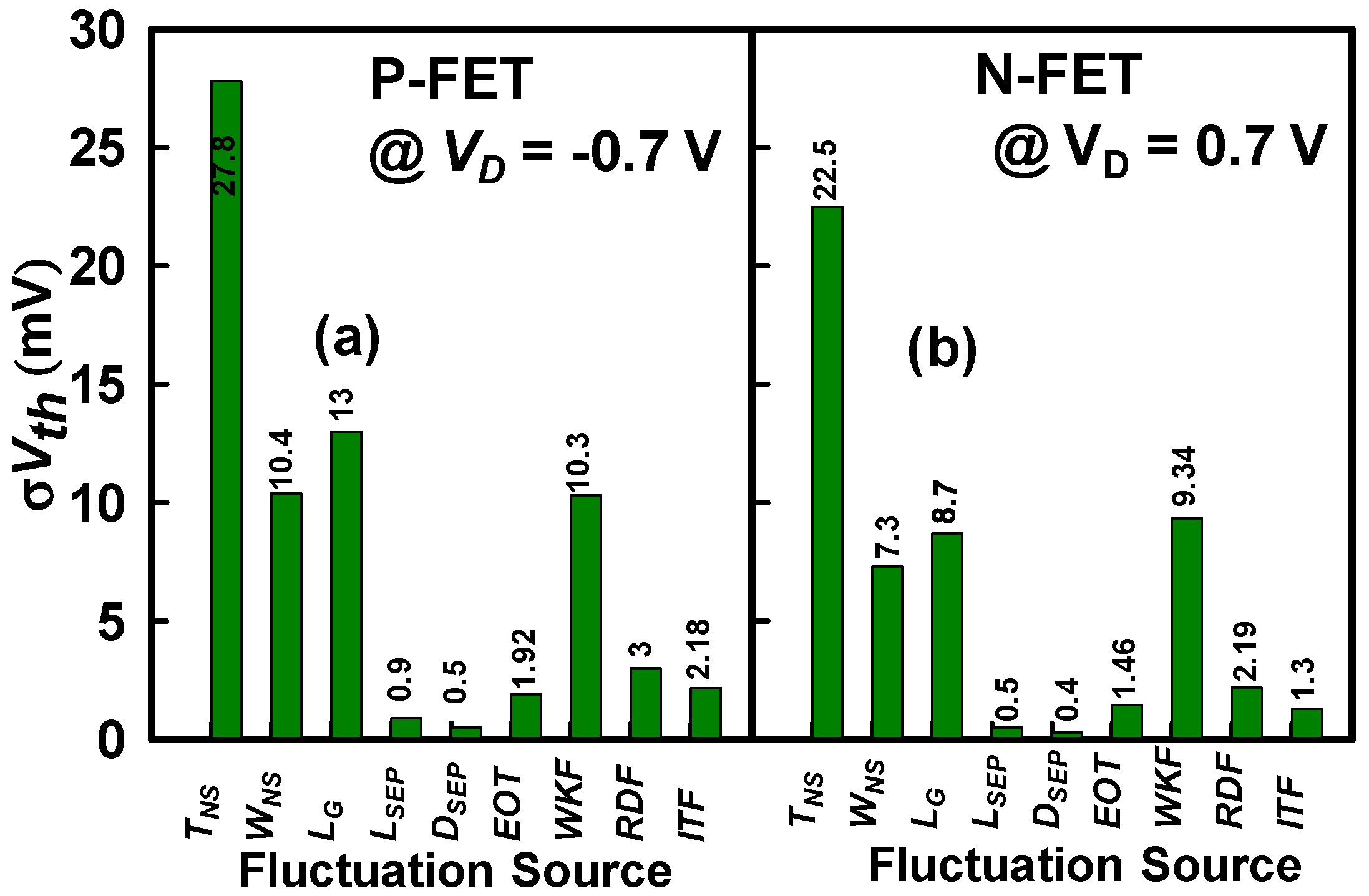
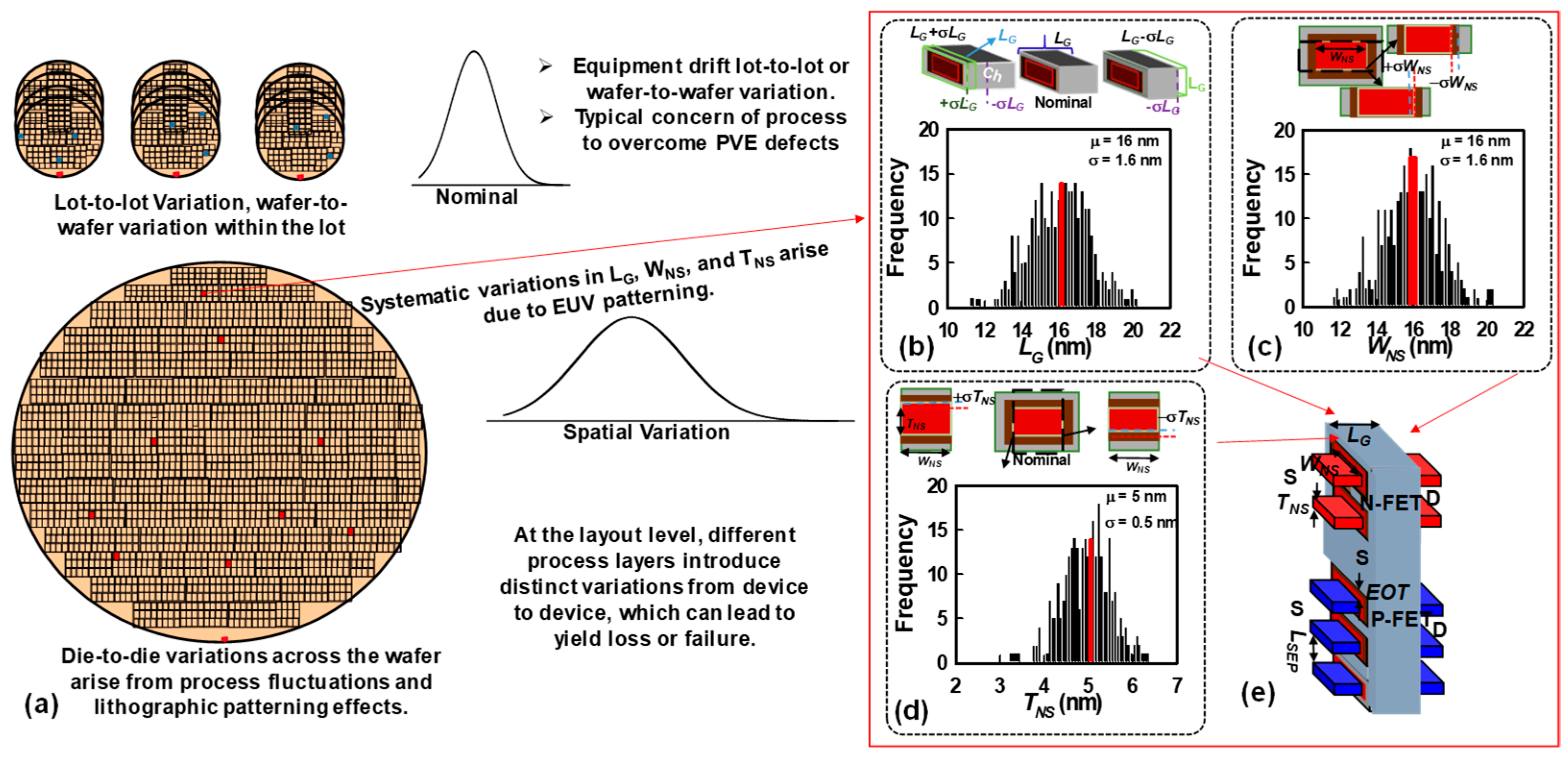
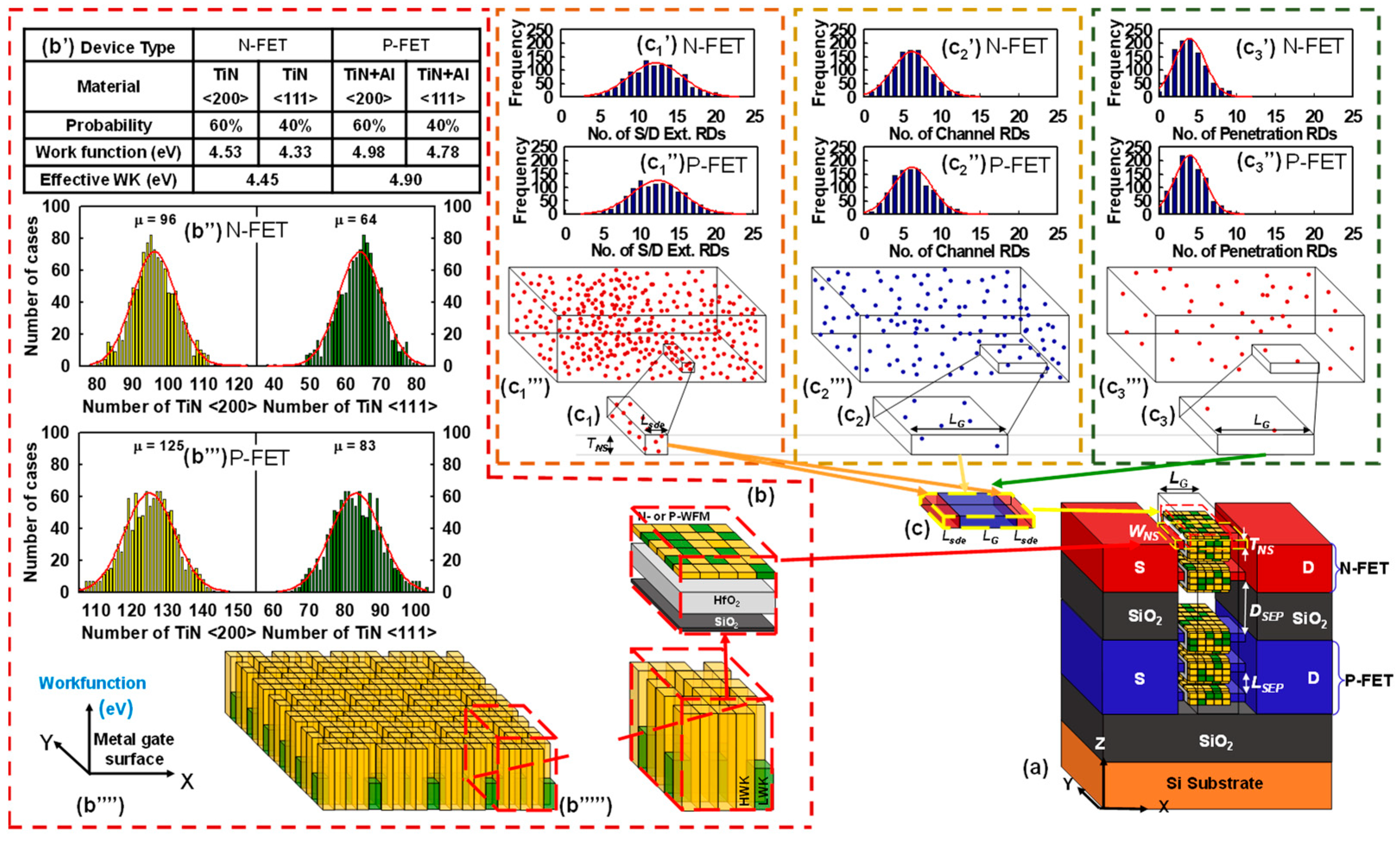
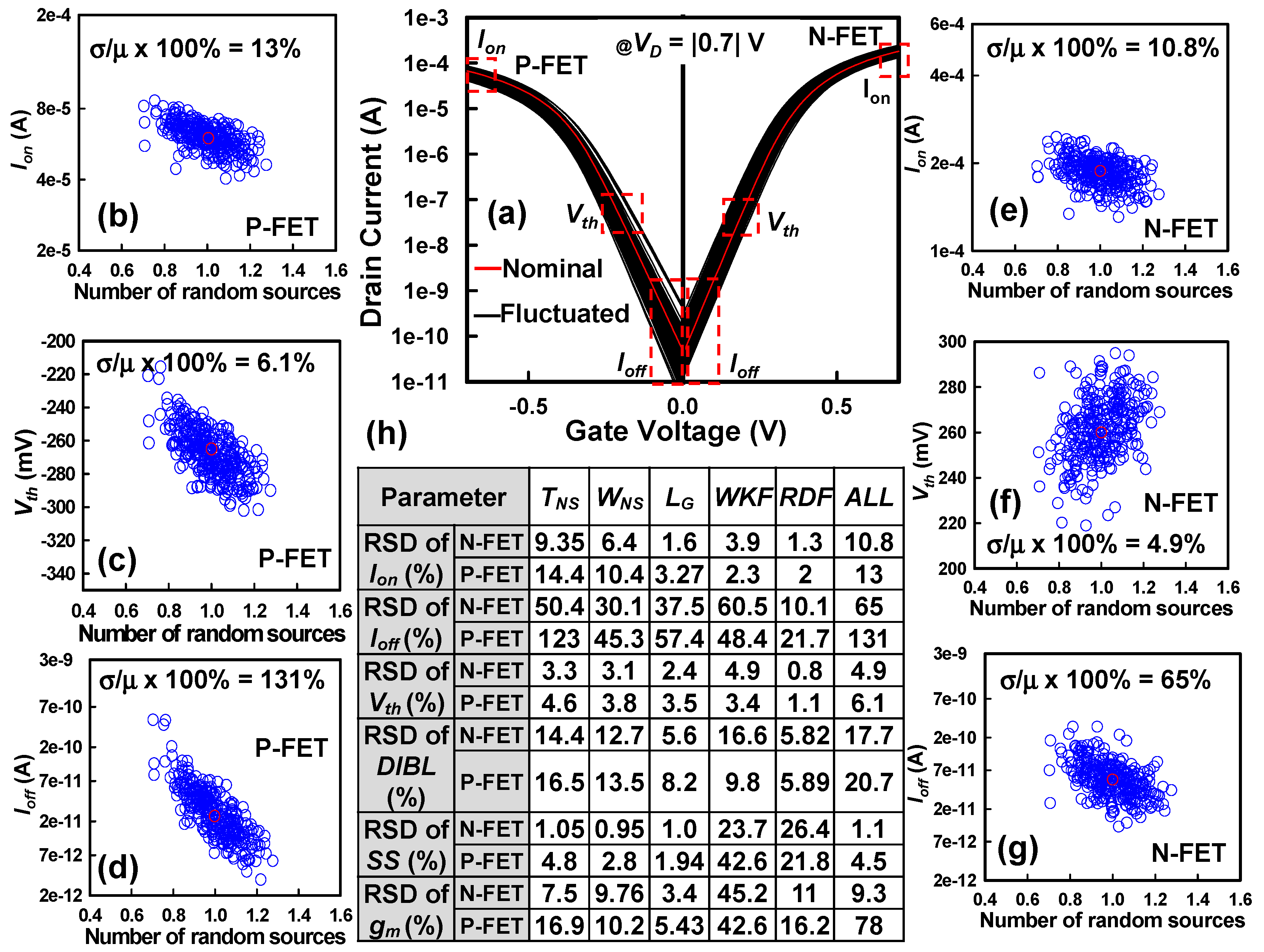
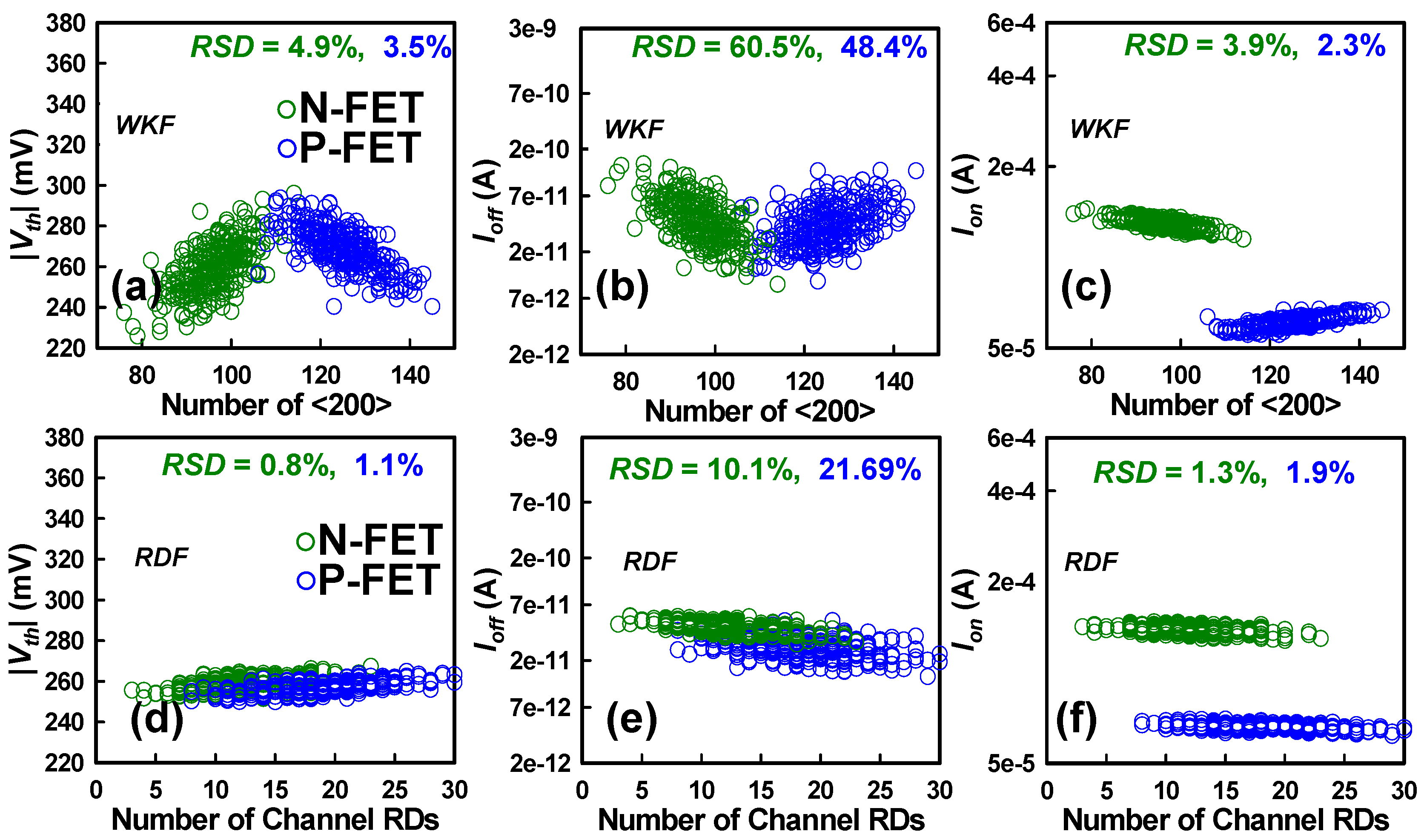


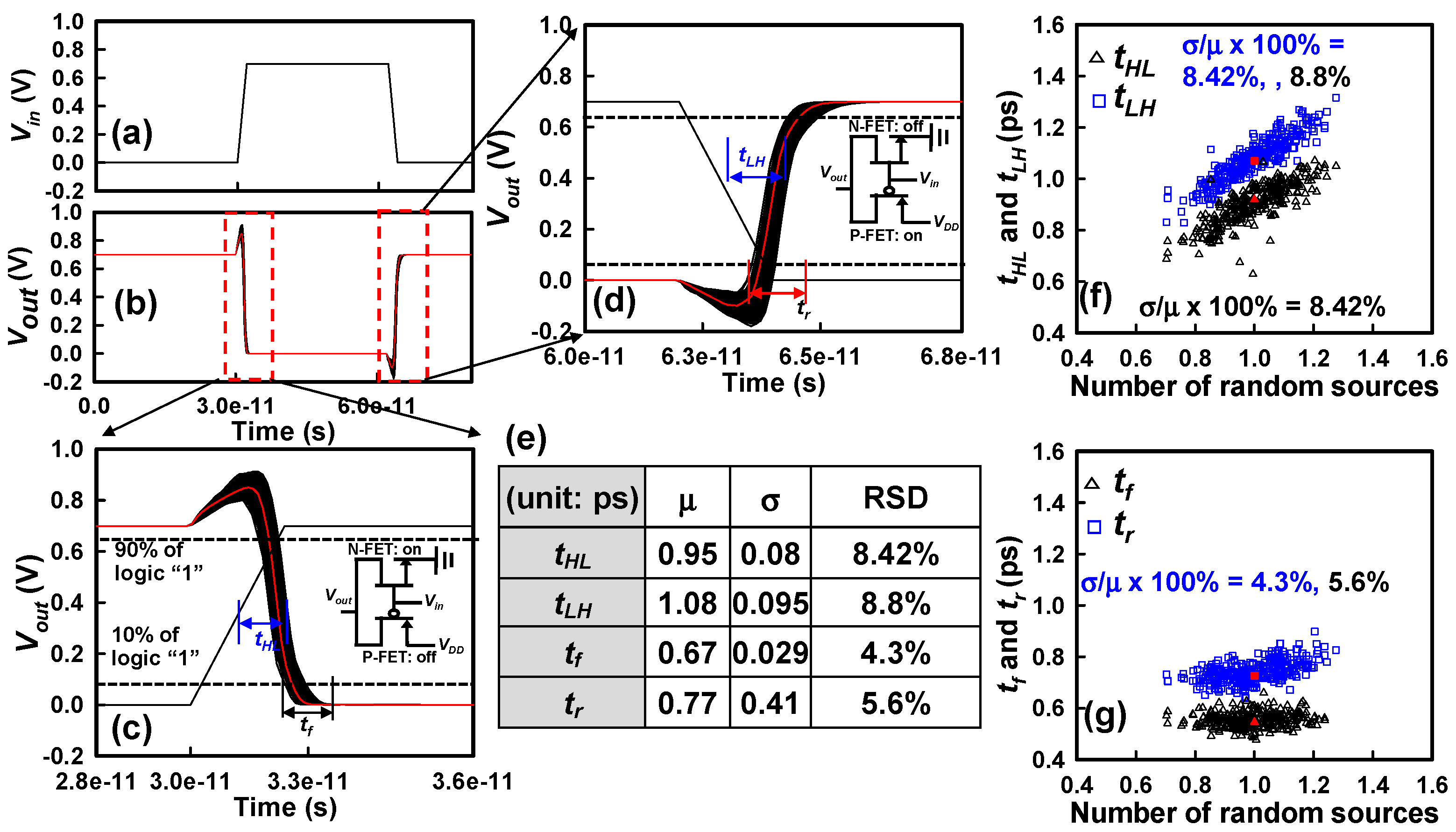
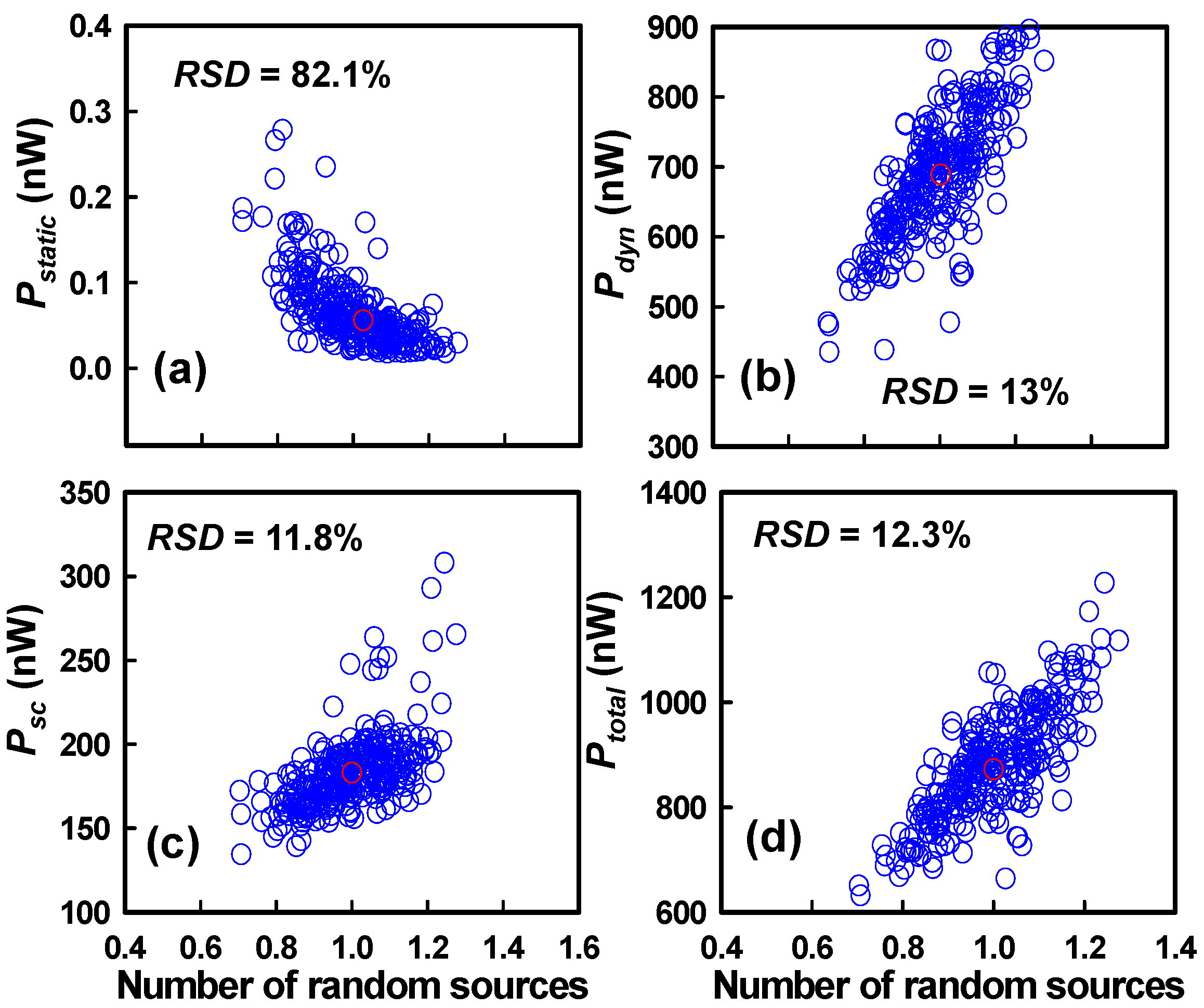
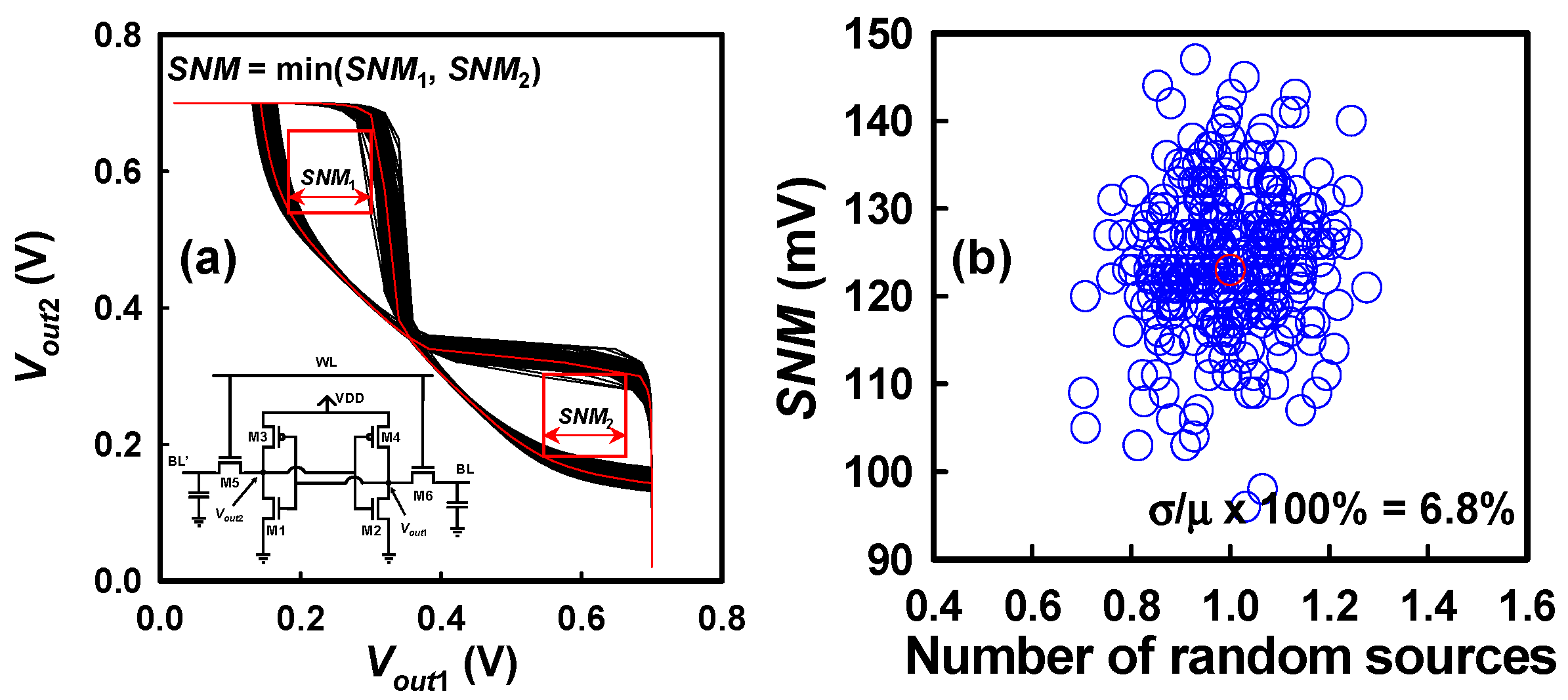
| Device Parameter | Value | |
| Channel length (nm) (LG) | 16 | |
| Channel doping (cm−3) | 6 × 1016 | |
| S/D extension (nm) | 5 | |
| S/D length (nm) | 12 | |
| Effective oxide thickness (nm) (EOT) | 0.66 | |
| Nanosheet thickness (nm) (TNS) | 5 | |
| Nanosheet width (nm) (WNS) | 16 | |
| Work function (eV) | 4.45, 4.80 | |
| S/D doping (cm−3) | 1 × 1020 | |
| S/D extension doping (cm−3) | 5 × 1018 | |
| The achieved characteristics | N-FET | P-FET |
| Threshold voltage (Vth) (mV) | 260 | −260 |
| Off-state current (Ioff) (A) | 3.5 × 10−11 | 4.11 × 10−11 |
| On-state current (Ion) (A) | 3.3 × 10−4 | 2 × 10−4 |
| Subthreshold slope (SS) (mV/dec) | 62 | 72 |
| Drain-induced barrier lowering (DIBL) (mV/V) | 30 | 49 |
| Parameter | Device | TNS | WNS | LG | WKF | RDF | RSDALL | RSDSUM |
|---|---|---|---|---|---|---|---|---|
| RSD of Ion (%) | N-FET | 9.35 | 6.4 | 1.6 | 3.9 | 1.3 | 10.8 | 12.2 |
| P-FET | 14.4 | 10.4 | 3.27 | 2.3 | 2 | 13 | 18.3 | |
| RSD of Ioff (%) | N-FET | 50.4 | 30.1 | 37.5 | 60.5 | 10.1 | 65 | 92.75 |
| P-FET | 123 | 45.3 | 57.4 | 48.4 | 21.7 | 131 | 152.6 | |
| RSD of Vth (%) | N-FET | 3.3 | 3.1 | 2.4 | 4.9 | 0.8 | 4.9 | 7.2 |
| P-FET | 4.6 | 3.8 | 3.5 | 3.4 | 1.1 | 6.1 | 7.8 | |
| RSD of DIBL (%) | N-FET | 14.4 | 12.7 | 5.6 | 16.6 | 5.82 | 17.7 | 26.7 |
| P-FET | 16.5 | 13.5 | 8.2 | 9.8 | 5.89 | 20.7 | 25.6 | |
| RSD of SS (%) | N-FET | 1.05 | 0.95 | 1.0 | 23.7 | 26.4 | 1.1 | 35.6 |
| P-FET | 4.8 | 2.8 | 1.94 | 42.6 | 21.8 | 4.5 | 48.2 | |
| RSD of gm (%) | N-FET | 7.5 | 9.76 | 3.4 | 45.2 | 11 | 9.3 | 48.3 |
| P-FET | 16.9 | 10.2 | 5.43 | 42.6 | 16.2 | 78 | 50 |
Disclaimer/Publisher’s Note: The statements, opinions and data contained in all publications are solely those of the individual author(s) and contributor(s) and not of MDPI and/or the editor(s). MDPI and/or the editor(s) disclaim responsibility for any injury to people or property resulting from any ideas, methods, instructions or products referred to in the content. |
© 2025 by the authors. Licensee MDPI, Basel, Switzerland. This article is an open access article distributed under the terms and conditions of the Creative Commons Attribution (CC BY) license (https://creativecommons.org/licenses/by/4.0/).
Share and Cite
Kola, S.R.; Li, Y. Simultaneously Estimating Process Variation Effect, Work Function Fluctuation, and Random Dopant Fluctuation of Gate-All-Around Silicon Nanosheet Complementary Field-Effect Transistors. Nanomaterials 2025, 15, 1306. https://doi.org/10.3390/nano15171306
Kola SR, Li Y. Simultaneously Estimating Process Variation Effect, Work Function Fluctuation, and Random Dopant Fluctuation of Gate-All-Around Silicon Nanosheet Complementary Field-Effect Transistors. Nanomaterials. 2025; 15(17):1306. https://doi.org/10.3390/nano15171306
Chicago/Turabian StyleKola, Sekhar Reddy, and Yiming Li. 2025. "Simultaneously Estimating Process Variation Effect, Work Function Fluctuation, and Random Dopant Fluctuation of Gate-All-Around Silicon Nanosheet Complementary Field-Effect Transistors" Nanomaterials 15, no. 17: 1306. https://doi.org/10.3390/nano15171306
APA StyleKola, S. R., & Li, Y. (2025). Simultaneously Estimating Process Variation Effect, Work Function Fluctuation, and Random Dopant Fluctuation of Gate-All-Around Silicon Nanosheet Complementary Field-Effect Transistors. Nanomaterials, 15(17), 1306. https://doi.org/10.3390/nano15171306







